
Hungary
The caves of Aggtelek Karst
Aggtelek, this little village in the north of Hungary which has given name to the Hungarian part of surrounding karst area as well as to the national park established there, was already among the country’s famous sights in the 18th century: the huge cave opening near the village and its remarkable dripstone formations have attracted visitors from remote parts of the worlds ever since.
It was the Baradla Cave that earned the karst area a reputation, and yet it is only one of the diverse caves in the region. Divided only by the national border, the Aggtelek Karst and Slovak Karst is the geographically homogenous region extending over 60,000 hectares and containing to our present knowledge over 1000 smaller and larger caves. Their morphological diversity, and characteristic fauna, as well as archeological and historical value, make this underground world one of the most complex examples of subterranean karstic phenomena occurring at medium altitude in the temperate zone.
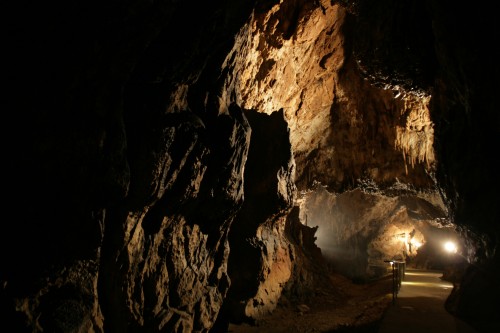
Touristic part of the Baradla cave. Photo by Vidmantas Balkūnas.
The fact that these values are outstandingly important on a globe scale has been confirmed by its being given the highest international designation: based on a joint proposal by Hungary and Slovakia, the caves of the Aggtelek Karst and Slovakia Karst were placed on the World's heritage list by Unesco World Heritage Committee in 1995.
The exploration of the underground world
There is archeological evidence that some caves in Aggtelek Karst and Slovak Karst were already by prehistoric Man: since excavations began in the Baradla Cave in 1876, more than 30 archaeological sites have been found in the caves, embracing about 35,000 years of the evolutions of human culture.
The most significant of these sites is the Baradla caves and its Slovakian part called Domica, were finds occasionally include tools used by the late Palaeolithic Man. The foreground of the cave entrances and adjacent spacious chambers contained the richest remains from Bukkian culture evidence of pile-dwellings, fine linear pattern pottery as well as stone and bone tools in abundance.
Although the number of known caves in Aggtelek National park has since grown to 262, and the total length of explored passages to 47 km, the search for new caves and passages still continues. Behind the impenetrable narrowings, breakdowns and water – filling siphons, this underground world was still many secrets in store.
[Source: “The caves of the Aggtelek Karst” / Josvafo / Hungary / 2003]
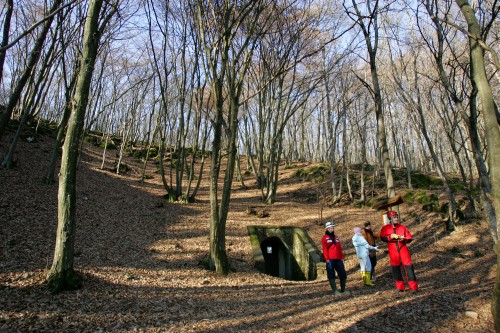
Most caves in Aggtelek are locked. Photo by Vidmantas Balkūnas.
Photos from the expedition to Aggtelek in 2008 December/ 2009 January
The Beke Cave
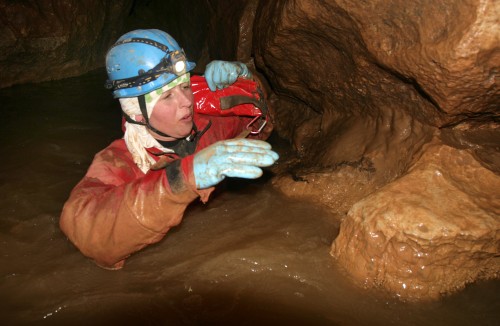
"Comparatively dry - no need for wetsuits" river of Beke. Photo by Vidmantas Balkūnas.
The second longest cave in the Aggtelek Karst after Baradla – Domica cave system, and also third longest in all Hungary. The active stream was formed in Triassic limestone. The 4-5 meters wide 4-10 meters high meandering main passage is lined with scour grooves. The calcite deposited by the Komlos stream constantly builds the rimstones of the main branch. A chain of the 123 rimstone pools and the 430 rimstones are the predominant features of the cave. Making its way to Josvafo through 16 siphons, the stream appears on the surface at the Komlos spring. Besides the morphological assets (meanders, canyons, chimneys and dissolved rock formations) and the diversity of its speleothems it’s a major bat roost as well. Based on this features the cave was ranked among the strictly protected caves in 1982.
A dye-tracing research proved that the cave system running parallel with the Baradla existed. The 7.2 kilometres long system was explored by Laszlo Jakucs and his team on 4th August 1952, by digging the Bibic doline. To make access easier, two artificial shafts were built at the two ends. Even the first explorer reported about the positive health effects of the cave. Further studies and measurements justified this experience, and after establishing a sanatorium in 1959, the cave was declared a medical cave in 1969. Visitors a admitted to the cave on a advanced booking.
Meteor cave
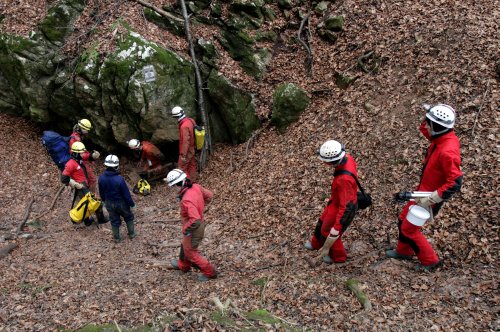
Entrance of the cave Meteor. Photo by Vidmantas Balkūnas.
The cave belongs to the biggest drainage system o the Alsohegy , opening about 415 meters sea level. Its was formed in Triassic limestone, its total length is 1672 meters, its vertical extension is 127 meters. Percolations water forms cascades and two subterrain cliffs, but their flow rate greatly depends on the actual surface precipitations. The Temporarily inactive main passage descends diagonally, and lower part Hungary’s second largest cave chamber can be found. The Chambers of Titans is 90 meters long and 20-30 meters wide, and some of its stalagmites and columns are tall as 15 meters. The astonishing sight is even more spectacular with the others speleothems of various shape and colors: large flowstone surfaces, abundant eccentrics. Dye tracing has proved the hydrological connection, along with other nearby potholes, with the Vecsem spring at the foot the Also-hegy. It has been strictly protected cave since 1982.
Its exploration started in 1962 with the digging of the Kisvizes doline by the Voros Meteors caving division; Dr. Gyorgy Denes led the operations. The Meteor cave can only be visited with the permit issued by the Aggtelek National Park, and it requires technical equipment and mountaineering training.
Kosuth cave
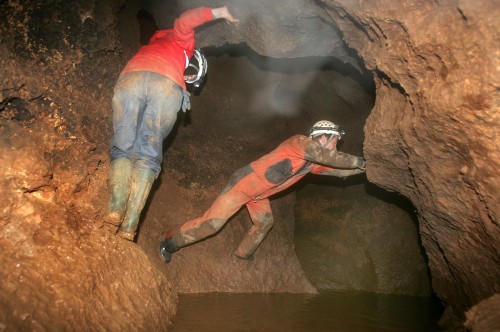
The river of the Kosuth cave. Photo by Vidmantas Balkūnas.
The cave of Nagy - Tohonya Spring can be found near Josvafo. Special limestone formations are characteristic to the Kossuth Cave that has been formed by heavy erosion. The route passes by stone columns and crest formed by erosions then reaches The Great Lake where visitors have to go through a cable rope bridge hanging above the lake. The final station of the tours is the Lake of Hopeless siphon.


